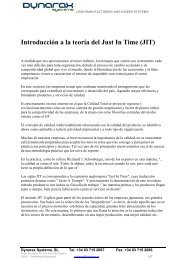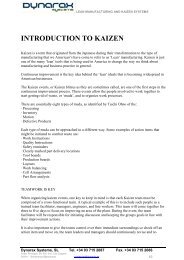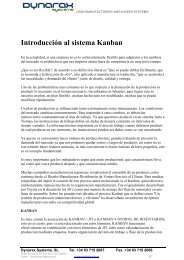ENG - Lean - Dynarax
ENG - Lean - Dynarax
ENG - Lean - Dynarax
You also want an ePaper? Increase the reach of your titles
YUMPU automatically turns print PDFs into web optimized ePapers that Google loves.
<strong>Lean</strong> process<br />
LEAN MANUFACTURING AND KAIZEN SYSTEMS<br />
Many business processes and especially manufacturing are based on serial processes, where<br />
things are passed down a chain of processes, with value being added at each point. Within this<br />
system there is massive opportunity for inefficiency and waste, such as buffer stores, things<br />
getting lost, breakdowns, etc.<br />
A lean system has none of this fat. Going lean means removing all waste from the system. This<br />
has many implications, such as:<br />
• Gaining a true understanding how things work so you can constantly improve, reduce<br />
waste and increase efficiency.<br />
• Reducing buffer storage to the absolute minimum, which makes everything connected: if<br />
one point in the system breaks down, everyone is very rapidly also affected.<br />
• Attention to bottlenecks, including when up-stream to suppliers and downstream to<br />
customers.<br />
• Being able to rapidly change the system to work on different products.<br />
• Having flexible, multi-skilled people who can perform such changes.<br />
• Having systems and management that engenders such a capable and motivated<br />
workforce.<br />
Thus parts and material should arrive at any point just as they are needed, and not before. This is<br />
known as Just In Time (JIT) and is the perfection that is sought, and can be far more closely<br />
attained than old systems which use large buffer stores to cover up inefficiencies in the system.<br />
JIT principles have been adopted in many other areas further afield from the original factory<br />
floor. For example Just In Time software compilers compile code just before it is needed.<br />
Toyota is consistently recognized as a leader and originator in this methodology (which helps to<br />
explain why many of the terms associated with it are Japanese).<br />
Associated concepts:<br />
Jidoka<br />
Jidoka, means, in the production context, not allowing defective parts to go from one work<br />
station to the next. It specifically refers to machines or the production line itself being able to<br />
stop automatically in abnormal conditions (for example, when a machine breaks down or when<br />
defective parts are produced). This Autonomation (as it is also called) allows machines to run<br />
autonomously, as they will stop when a problem occurs. Ultimately, it is about transferring<br />
human (or better) intelligence to machines.<br />
Jidoka is also used when individual people encounter a problem at their work station. They are<br />
responsible for correcting the problem - if they cannot, they should stop the line rather than let<br />
the defective part do.<br />
The principle was first used by Sakichi Toyoda at the beginning of the 20th century when he<br />
invented a loom which stopped when the thread broke.<br />
<strong>Dynarax</strong> Systems, SL Tel. +34 93 715 2687 Fax. +34 93 715 2686<br />
Avda. Principal, 29. Pol. Ind. Can Clapers<br />
08181 – Sentmenat (Barcelona) comercial@dynarax.es 1/4
Poka yoke<br />
LEAN MANUFACTURING AND KAIZEN SYSTEMS<br />
People are human and cannot be expected to do everything like a machine, exactly the same each<br />
time. A simple distraction can lead to a part of their work being done wrong. It is also not<br />
necessarily their fault, as poorly-designed processes that require a great deal of attention can<br />
contribute severely to problems.<br />
Poka yoke is a Japanese term which simply means mistake-proofing or fool-proofing and implies<br />
designing work and processes such that it is impossible or very difficult to for people to make<br />
mistakes. It is a simple principle that can lead to massive savings.<br />
Thus, for example, a plate that must be screwed down in one orientation only could have the<br />
screw holes in non-symmetrical positions so that it can only be screwed in the right orientation.<br />
The principle can be easily used in non-manual situations (where mistakes can have huge costs<br />
associated), for example in a project management process, checklists may be used at various<br />
times in the project to check that particular tasks have not been forgotten.<br />
5Ss of the workplace<br />
The '5Ss' of the workplace are the Japanese words:<br />
• Seiri = organization : separate out all the things that are not necessary and eliminate them<br />
or tidy them away<br />
• Seiton = neatness : arrange the essential things in order so that they can be quickly and<br />
easily accessed and put away<br />
• Seiso = cleaning : keep machines and working environment clean (everyone's job--no<br />
cleaners needed)<br />
• Seiketsu = standardization : make cleaning and checking a routine practice; maintain a<br />
pleasant environment<br />
• Shitsuke = discipline : standardize the previous four steps and constantly improve them;<br />
creating good habits<br />
In a tidy and organized workplace, errors are minimized, work is speeded up and small problems<br />
are made visible.<br />
These have been translated (more than once) into five Ss in the English language:<br />
• Seiri --> sort, structurize, sort out<br />
• Seiton --> straighten, systematize, systematic arrangement<br />
• Seiso --> scrub, sanitize, spic and span<br />
• Seiketsu --> systematize, standardize<br />
• Shitsuke --> standardize, self-discipline<br />
<strong>Dynarax</strong> Systems, SL Tel. +34 93 715 2687 Fax. +34 93 715 2686<br />
Avda. Principal, 29. Pol. Ind. Can Clapers<br />
08181 – Sentmenat (Barcelona) comercial@dynarax.es 2/4
LEAN MANUFACTURING AND KAIZEN SYSTEMS<br />
Let's leave the last word to Hiroyuki Hirano, author of 5S: Five Pillars of the Visual Workplace:<br />
"A company that cannot successfully implement the 5S's cannot expect to effectively<br />
integrate JIT, re-engineering, or any other large-scale change. Good workplaces develop<br />
beginning with the 5S's. Bad workplaces fall apart beginning with the 5S's."<br />
Takt time<br />
"Takt" is the German word for the baton, as used by a conductor to control the speed at which<br />
the orchestra plays. In manufacturing, takt time is a calculated value that gives the speed at<br />
which parts must be manufactured in order to satisfy demand.<br />
To calculate takt time:<br />
1. Determine the daily order or demand volume. (eg. 21 instruments per day).<br />
2. Determine the number of time units (often minutes) in a working day. (eg. in an 8 hr day<br />
with 1 hour for lunch and no other breaks there is 7 x 60 = 420 minutes).<br />
3. Divide the number of minutes by the number of products needed. (420÷21 = 20. This<br />
means that one unit must be manufactured every 20 minutes in order to meet demand.<br />
Takt time thus is 20 minutes.)<br />
The takt time gives 'production slots' into which products must be manufactured to meet<br />
demand.<br />
The other form of time that is important is cycle time, which is the measured time that it actually<br />
takes to make a product. If this, plus any set up times, is greater than the takt time, then it is time<br />
for process improvement!<br />
If you have a totally controlled and synchronized lean system, the takt time of all processes in<br />
the entire supply chain will be linked, even to controlling when the customers purchase.<br />
Gemba<br />
According to Masaaki Imai, the author of 'Gemba Kaizen':<br />
"Gemba in Japanese means the place where all activities are actually taking place; in<br />
other words, the place where value is added. In case of the manufacturing industry,<br />
gemba is the shop-floor; for the hotel industry, it is the place where the food is actually<br />
being cooked; and in case of the service industry; it is everywhere. Gemba is thus the<br />
most precious place for the management."<br />
<strong>Dynarax</strong> Systems, SL Tel. +34 93 715 2687 Fax. +34 93 715 2686<br />
Avda. Principal, 29. Pol. Ind. Can Clapers<br />
08181 – Sentmenat (Barcelona) comercial@dynarax.es 3/4
LEAN MANUFACTURING AND KAIZEN SYSTEMS<br />
He thus exhorts managers to 'go to the Gemba'. Gemba also gets used as a prefix for things that<br />
happen on the shop floor. Imai describes Gemba Kaizen, continuous improvement on the shop<br />
floor, thus:<br />
"The key is to be inquisitive. If I, as a manager, notice a leak in one of the machines I must be<br />
able to track down the problem. I must know that the leak is because of a gap, that the gap has<br />
been caused by the vibrating action of the machine. And that the vibration has caused two<br />
specific screws to loosen and cause the gap. The solution could be in tightening those two<br />
screws every morning before the machine is started. Thus, avoiding the possibility of a leak."<br />
Another Gemba is the 'Gemba-Cho' is a 'working foreman', a kind of on-the-job teacher, whose job is to<br />
both do a job and also train other people in the job.<br />
<strong>Dynarax</strong> Systems, SL Tel. +34 93 715 2687 Fax. +34 93 715 2686<br />
Avda. Principal, 29. Pol. Ind. Can Clapers<br />
08181 – Sentmenat (Barcelona) comercial@dynarax.es 4/4





